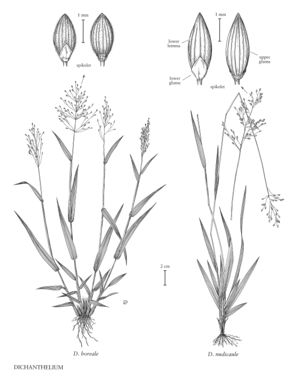Difference between revisions of "Dichanthelium boreale"
FNA>Volume Importer |
FNA>Volume Importer |
||
| Line 8: | Line 8: | ||
|name=Panicum boreale var. michiganense | |name=Panicum boreale var. michiganense | ||
|authority=unknown | |authority=unknown | ||
| − | }}{{Treatment/ID/Synonym | + | }} {{Treatment/ID/Synonym |
|name=Panicum boreale | |name=Panicum boreale | ||
|authority=unknown | |authority=unknown | ||
| Line 23: | Line 23: | ||
-->{{Treatment/Body | -->{{Treatment/Body | ||
|distribution=Conn.;N.J.;N.Y.;D.C;Wis.;W.Va.;N.H.;N.C.;Tenn.;Pa.;R.I.;N.B.;Nfld. And Labr. (Labr.);N.S.;Ont.;P.E.I.;Que.;Va.;Vt.;Ill.;Ga.;Ind.;Iowa;Maine;Md.;Mass.;Ohio;Mo.;Minn.;Mich.;Ky. | |distribution=Conn.;N.J.;N.Y.;D.C;Wis.;W.Va.;N.H.;N.C.;Tenn.;Pa.;R.I.;N.B.;Nfld. And Labr. (Labr.);N.S.;Ont.;P.E.I.;Que.;Va.;Vt.;Ill.;Ga.;Ind.;Iowa;Maine;Md.;Mass.;Ohio;Mo.;Minn.;Mich.;Ky. | ||
| − | |discussion=<p>Dichanthelium boreale grows in open woodlands and thickets, wet meadows, and fields. It is restricted to the Flora region. The primary panicles are mostly open-pollinated and are produced in May and June; the secondary panicles are predominantly cleistogamous and are produced from mid-June into October.</p><!-- | + | |discussion=<p><i>Dichanthelium boreale</i> grows in open woodlands and thickets, wet meadows, and fields. It is restricted to the Flora region. The primary panicles are mostly open-pollinated and are produced in May and June; the secondary panicles are predominantly cleistogamous and are produced from mid-June into October.</p><!-- |
| − | --><p>Dichanthelium boreale occasionally hybridizes with D. acuminatum and D. xanthophysum, producing a sterile triploid sometimes called Panicum calliphyllum Ashe.</p> | + | --><p><i>Dichanthelium boreale</i> occasionally hybridizes with <i>D. acuminatum</i> and <i>D. xanthophysum</i>, producing a sterile triploid sometimes called <i>Panicum</i> calliphyllum Ashe.</p> |
|tables= | |tables= | ||
|references= | |references= | ||
| Line 45: | Line 45: | ||
|publication year= | |publication year= | ||
|special status= | |special status= | ||
| − | |source xml=https://jpend@bitbucket.org/aafc-mbb/fna-data-curation.git/src/ | + | |source xml=https://jpend@bitbucket.org/aafc-mbb/fna-data-curation.git/src/8f726806613d60c220dc4493de13607dd3150896/coarse_grained_fna_xml/V25/V25_1183.xml |
|subfamily=Poaceae subfam. Panicoideae | |subfamily=Poaceae subfam. Panicoideae | ||
|tribe=Poaceae tribe Paniceae | |tribe=Poaceae tribe Paniceae | ||
Revision as of 17:29, 18 September 2019
Plants cespitose. Basal rosettes well-differentiated; blades 2-4 cm, pubescent, reddish. Culms 18-75 cm, usually more than 1 mm thick, occasionally delicate, erect or ascending; nodes glabrous; internodes glabrous; fall phase with decumbent culms, branches arising from the lower and midculm nodes, rebranching 2-3 times, with small blades and secondary panicles compared to those on the culms, secondary panicles with 8-10 spikelets, partially included at maturity. Cauline leaves 3-5; sheaths shorter than the internodes, lower sheaths pubescent, upper sheaths glabrous, margins of all sheaths sparsely ciliate; ligules about 0.5 mm, of hairs; blades 5-11 cm long, 5-13 mm wide, thin, spreading to erect, usually glabrous, rarely pubescent abaxially, always glabrous adaxially, bases truncate to cordate, ciliate on the margins, blades of the flag leaves erect or ascending. Primary panicles 5-11 cm long, 3-8 cm wide, ovoid, long-exserted, with 40-220 spikelets. Spikelets 2-2.2 mm long, 0.8-1.3 mm wide, ellipsoid, usually reddish, shortly pubescent, subacute. Lower glumes 0.5-1 mm, triangular-ovate; lower florets sterile; upper florets slightly exceeding the upper glumes and lower lemmas, subacute. 2n = 18.
Distribution
Conn., N.J., N.Y., D.C, Wis., W.Va., N.H., N.C., Tenn., Pa., R.I., N.B., Nfld. And Labr. (Labr.), N.S., Ont., P.E.I., Que., Va., Vt., Ill., Ga., Ind., Iowa, Maine, Md., Mass., Ohio, Mo., Minn., Mich., Ky.
Discussion
Dichanthelium boreale grows in open woodlands and thickets, wet meadows, and fields. It is restricted to the Flora region. The primary panicles are mostly open-pollinated and are produced in May and June; the secondary panicles are predominantly cleistogamous and are produced from mid-June into October.
Dichanthelium boreale occasionally hybridizes with D. acuminatum and D. xanthophysum, producing a sterile triploid sometimes called Panicum calliphyllum Ashe.
Selected References
None.
